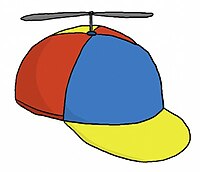Beanie (seamed cap): Difference between revisions
→Styles: questionable content that needs a source |
|||
| Line 4: | Line 4: | ||
==Description== |
==Description== |
||
Beanies are made by triangular sections of cloth joined by a button at the crown and seamed together around the sides |
Beanies are made by triangular sections of cloth joined by a button at the crown and seamed together around the sides, usually worn by douchebags. |
||
==Etymology== |
==Etymology== |
||
The term is said to derive from a type of headgear worn in some medieval universities; the yellow hats ("bejaunus," that is, "yellowbill" later "beanus," a term used for both the hats and the new students) evolved into the college beanies of later years.<ref>Black Greek 101: the culture, customs, and challenges of Black fraternities. Walter M. Kimbrough, Fairleigh Dickinson University PRess 2003 p. 38</ref> In [[Canada]], [[New Zealand]], [[Australia]], the [[United States]] and the [[United Kingdom]], the term "beanie" may also be applied to a knit cap known as a [[tuque]]. |
The term is said to derive from a type of headgear worn in some medieval universities; the yellow hats ("bejaunus," that is, "yellowbill" later "beanus," a term used for both the hats and the new students) evolved into the college beanies of later years.<ref>Black Greek 101: the culture, customs, and challenges of Black fraternities. Walter M. Kimbrough, Fairleigh Dickinson University PRess 2003 p. 38</ref> In [[Canada]], [[New Zealand]], [[Australia]], the [[United States]] and the [[United Kingdom]], the term "beanie" may also be applied to a knit cap known as a [[tuque]]. |
||
Revision as of 18:16, 4 June 2011
A beanie is a head-hugging brimless cap with or without a visor that was once popular among school boys.
Description
Beanies are made by triangular sections of cloth joined by a button at the crown and seamed together around the sides, usually worn by douchebags.
Etymology
The term is said to derive from a type of headgear worn in some medieval universities; the yellow hats ("bejaunus," that is, "yellowbill" later "beanus," a term used for both the hats and the new students) evolved into the college beanies of later years.[1] In Canada, New Zealand, Australia, the United States and the United Kingdom, the term "beanie" may also be applied to a knit cap known as a tuque.
History
A larger variant of the skullcap, the beanie was a working hat associated with blue collar laborers, welders, mechanics, and other tradesmen who needed to keep their hair back but for whom a brim would be an unnecessary obstruction.[citation needed] Beanies do sometimes have a very small brim, less than an inch deep, around the brow front. The baseball cap evolved from this kind of beanie, with the addition of a brim to block the sun.
By the mid 1940s, beanies fell out of popularity as a hat in favor of cotton visored caps like the baseball cap although, in the 1950s and possibly beyond, they were worn by college freshmen and various fraternities as a form of mild hazing. Lehigh University required freshmen to wear beanies, or "dinks," and other colleges including Franklin & Marshall, Gettysburg and Rutgers, may have had similar practices.[2]
In the early 1990s, the beanie saw a reemergence in popularity due to the "grunge" clothing trend as well as the popularization of snowboarding and other cold weather sports activities.[citation needed] The modern beanie is usually made of fleece, or special synthetic material that wicks moisture away. Woven versions, resembling tobogganing caps, are also popular sportswear accessories for winter sports—such as snowboarding.
Propeller beanie

In the late 1940s, science fiction fanzine artist Ray Nelson (himself still in high school) adopted the use of the propeller beanie as emblematic shorthand for science fiction fandom, in self-mockery of the popular image of fans as childish and concerned with ephemera (i.e., science fiction); references to it are ironically now used to identify old-fashioned fans, as opposed to more modern fans of media SF. The propeller beanie increased in popular use through comics, and eventually made its way onto the character of Beany Boy of "Beany and Cecil." Today, computer savvy and other technically proficient people are sometimes pejoratively referred to as propellerheads thanks to the one-time popularity of the propeller beanie.[3]
Styles
One popular style of the beanie during the early half of the twentieth century was a skullcap made of four or six felt panels sewn together to form the cap. The panels were often composed of two or more different colors to make them novel. This type of beanie was also very popular with college fraternities as they would often incorporate school colors into the beanie.
Another style of beanie was a formed and pressed wool hat with a flipped up brim that formed a band around the bottom of the cap. The band would often have a decorative repeating zig-zag or scalloped pattern cut around the edge. It was also quite common for schoolboys to adorn their beanies with buttons and pins.
Beanies are often constructed from yarn, using knitting or crochet techniques.
References
- ^ Black Greek 101: the culture, customs, and challenges of Black fraternities. Walter M. Kimbrough, Fairleigh Dickinson University PRess 2003 p. 38
- ^ Excerpt from "The GI Bill", by Michael D. Haydock
- ^ Merriam-Webster definition of propellerhead
